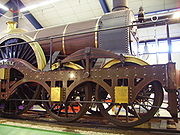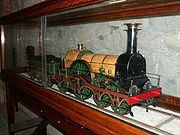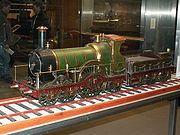
GWR Iron Duke Class
Encyclopedia
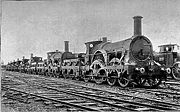
Great Western Railway
The Great Western Railway was a British railway company that linked London with the south-west and west of England and most of Wales. It was founded in 1833, received its enabling Act of Parliament in 1835 and ran its first trains in 1838...
Iron Duke Class 4-2-2
Whyte notation
The Whyte notation for classifying steam locomotives by wheel arrangement was devised by Frederick Methvan Whyte and came into use in the early twentieth century encouraged by an editorial in American Engineer and Railroad Journal...
was a class of broad gauge steam locomotive
Locomotive
A locomotive is a railway vehicle that provides the motive power for a train. The word originates from the Latin loco – "from a place", ablative of locus, "place" + Medieval Latin motivus, "causing motion", and is a shortened form of the term locomotive engine, first used in the early 19th...
s for express passenger train work.
History
The prototype locomotive, Great Western, was built as a 2-2-22-2-2
Under the Whyte notation for the classification of steam locomotives, 2-2-2 represents the wheel arrangement of two leading wheels on one axle two powered driving wheels on one axle, and two trailing wheels on one axle. The wheel arrangement both provided more stability and enabled a larger firebox...
locomotive in April 1846, but was soon converted to a 4-2-2
4-2-2
Under the Whyte notation for the classification of steam locomotives, 4-2-2 represents the wheel arrangement of four leading wheels on two axles, two powered driving wheels on one axle, and two trailing wheels on one axle....
arrangement. The remainder of the class entered service between April 1847 and July 1855.
Locomotives of the Iron Duke class were extremely fast and had an estimated top speed of about 80 mph (133 km/h). They were used to haul the Flying Dutchman
Flying Dutchman (train)
The Flying Dutchman was a named passenger train service from London Paddington to Exeter. It ran from 1849 until 1892, originally over the Great Western Railway and then the Bristol and Exeter Railway. As the GWR expanded, the destination of the train changed to Plymouth and briefly to .-Early...
express train which, for several decades, was the world's fastest train. In 1852 the daily service from London Paddington Station to Exeter
Exeter
Exeter is a historic city in Devon, England. It lies within the ceremonial county of Devon, of which it is the county town as well as the home of Devon County Council. Currently the administrative area has the status of a non-metropolitan district, and is therefore under the administration of the...
(194 miles) was achieved with an average speed of 53 mph (88 km/h); with the flatter section between London and Swindon
Swindon
Swindon is a large town within the borough of Swindon and ceremonial county of Wiltshire, in South West England. It is midway between Bristol, west and Reading, east. London is east...
covered at an average speed of 59 mph
.
From about 1865, the Iron Duke Class was known as the Alma Class.
In May to July 1870, three locomotives (Great Britain, Prometheus and Estaffete) were extensively rebuilt with new frames and boilers, but retaining their original names. Following these, further locomotives were built to similar specifications, entering service between August 1871 and July 1888. These new locomotives are generally referred to as the Rover class. Although these locomotives took the names of withdrawn locomotives of the original design, they were not rebuilt from them like the first three, but entirely new locomotives (though it is believed that Rover, Swallow and Balaklava may have included some parts from the earlier locomotives of those names).
Apart from the three conversions, the original locomotives were withdrawn between December 1870 and June 1884. Lord of the Isles (the last to be withdrawn) was initially preserved by the GWR at Swindon Works, but was scrapped in January 1906 owing to pressure of space. The three conversions were withdrawn between September 1880 and October 1887, while the other locomotives to the later design were all withdrawn with the end of the GWR broad gauge in May 1892 (except Hirondelle, which had been withdrawn in December 1890).
Many of the nameplates can be seen at the National Railway Museum
National Railway Museum
The National Railway Museum is a museum in York forming part of the British National Museum of Science and Industry and telling the story of rail transport in Britain and its impact on society. It has won many awards, including the European Museum of the Year Award in 2001...
and at Swindon Steam Railway Museum
Swindon Steam Railway Museum
STEAM – Museum of the Great Western Railway, also known as Swindon Steam Railway Museum, is located at the site of the old railway works in Swindon, England – Wiltshire's 'railway town'...
, while the driving wheels from Lord of the Isles can also be seen at Swindon.
2-2-2 Great Western
The prototype for this class was named the Great Western and built in 1846. Named after the railway, it was designed to show how the 2-2-2 express engines could be improved; its 8 feet (2.4 m) driving wheels were a foot larger than those of the successful Fire Fly classGWR Firefly Class
The Firefly was a class of broad gauge 2-2-2 steam locomotives used for passenger services on the Great Western Railway. The class was introduced into service between March 1840 and December 1842, and withdrawn between December 1863 and July 1879....
. It broke its leading axle after a short while in service and was subsequently rebuilt as a 4-2-2, becoming part of the Iron Duke class.
Iron Duke class
| Name | Built | Withdrawn | Details and information |
|---|---|---|---|
| Great Western | 1846 | 1870 | rebuilt from the 2-2-2 The first, prototype, locomotive, with 18'11½" wheelbase. Name of the Great Western Railway Great Western Railway The Great Western Railway was a British railway company that linked London with the south-west and west of England and most of Wales. It was founded in 1833, received its enabling Act of Parliament in 1835 and ran its first trains in 1838... company and Brunel Isambard Kingdom Brunel Isambard Kingdom Brunel, FRS , was a British civil engineer who built bridges and dockyards including the construction of the first major British railway, the Great Western Railway; a series of steamships, including the first propeller-driven transatlantic steamship; and numerous important bridges... 's first steam ship, SS Great Western SS Great Western SS Great Western of 1838, was an oak-hulled paddle-wheel steamship; the first purpose-built for crossing the Atlantic and the initial unit of the Great Western Steamship Company. Designed by Isambard Kingdom Brunel, Great Western proved satisfactory in service and was the model for all successful... of 1838. |
| Great Britain | 1847 | 1880 | Second production locomotive, one of the first batch built, 18'6" wheelbase. Name of the country, Great Britain, and Brunel Isambard Kingdom Brunel Isambard Kingdom Brunel, FRS , was a British civil engineer who built bridges and dockyards including the construction of the first major British railway, the Great Western Railway; a series of steamships, including the first propeller-driven transatlantic steamship; and numerous important bridges... 's SS Great Britain SS Great Britain SS Great Britain was an advanced passenger steamship designed by Isambard Kingdom Brunel for the Great Western Steamship Company's transatlantic service between Bristol and New York. While other ships had previously been built of iron or equipped with a screw propeller, Great Britain was the first... steamship of 1843. |
| Iron Duke | 1847 | 1871 | One of the first batch built, with 18'6" wheelbase. Name of the class, Iron Duke Iron Duke Iron Duke may refer to:*Two dukes, both military officers, were nicknamed the "Iron Duke" during their lifetimes:**Arthur Wellesley, 1st Duke of Wellington***The Iron Duke , 1934 film starring George Arliss as Wellington... was a reference to the Duke of Wellington Arthur Wellesley, 1st Duke of Wellington Field Marshal Arthur Wellesley, 1st Duke of Wellington, KG, GCB, GCH, PC, FRS , was an Irish-born British soldier and statesman, and one of the leading military and political figures of the 19th century... . |
| Emperor | 1847 | 1873 | One of the first batch built, with 18'6" wheelbase. Emperor Emperor An emperor is a monarch, usually the sovereign ruler of an empire or another type of imperial realm. Empress, the female equivalent, may indicate an emperor's wife or a woman who rules in her own right... is a ruler of an empire |
| Lightning | 1847 | 1878 | One of the first batch built, with 18'6" wheelbase. lightning Lightning Lightning is an atmospheric electrostatic discharge accompanied by thunder, which typically occurs during thunderstorms, and sometimes during volcanic eruptions or dust storms... is a fast and powerful discharge of electrostatic energy from clouds |
| Pasha | 1847 | 1876 | One of the first batch built, with 18'6" wheelbase. pasha Pasha Pasha or pascha, formerly bashaw, was a high rank in the Ottoman Empire political system, typically granted to governors, generals and dignitaries. As an honorary title, Pasha, in one of its various ranks, is equivalent to the British title of Lord, and was also one of the highest titles in... is a Turkish chieftain |
| Sultan | 1847 | 1874 | One of the first batch built, with 18'6" wheelbase. Involved in an accident at Ealling: it ran into some goods wagons that were being shunted, and six passengers were killed. Sultan Sultan Sultan is a title with several historical meanings. Originally, it was an Arabic language abstract noun meaning "strength", "authority", "rulership", and "dictatorship", derived from the masdar سلطة , meaning "authority" or "power". Later, it came to be used as the title of certain rulers who... is a Muslim ruler. |
| Courier | 1848 | 1877 | courier Courier A courier is a person or a company who delivers messages, packages, and mail. Couriers are distinguished from ordinary mail services by features such as speed, security, tracking, signature, specialization and individualization of express services, and swift delivery times, which are optional for... is a person who carries packages |
| Dragon | 1848 | 1872 | dragon Dragon A dragon is a legendary creature, typically with serpentine or reptilian traits, that feature in the myths of many cultures. There are two distinct cultural traditions of dragons: the European dragon, derived from European folk traditions and ultimately related to Greek and Middle Eastern... is a mythological fire-breathing beast |
| Hirondelle | 1848 | 1873 | hirondelle Hirondelle Hirondelle may refer to:* Hirondelle * Hirondelle News Agency, a news organisation based in Lausanne, Switzerland* Dassault Hirondelle, a French utility transport aircraft of the 1960s* Western Hirondelle, a kit airplane... is French French language French is a Romance language spoken as a first language in France, the Romandy region in Switzerland, Wallonia and Brussels in Belgium, Monaco, the regions of Quebec and Acadia in Canada, and by various communities elsewhere. Second-language speakers of French are distributed throughout many parts... for a swallow Swallow The swallows and martins are a group of passerine birds in the family Hirundinidae which are characterised by their adaptation to aerial feeding... |
| Rougemont | 1848 | 1879 | Rougemont Castle Rougemont Castle Rougemont Castle is the historic castle of Exeter.The castle was first built in 1068 to help William the Conqueror maintain control over the city. It is perched on an ancient volcanic plug, overlaying remains of the Roman city of Isca Dumnoniorum... is a site of historic interest in Exeter, within the GWR region |
| Tartar | 1848 | 1876 | Tartar Tartar Tartar may refer to: *An alternative spelling of the name Tatars, an ethnic group in present-day Russia.* Tartars, the name of the athletic teams from 1927–1999 at Wayne State University in Detroit.*Tartar sauce*Tartar on teeth, hardened dental plaque... is an eastern European Turkic speakers |
| Warlock | 1848 | 1874 | warlock Warlock The term warlock in origin means "traitor, oathbreaker".In early modern Scots, the word came to be used as the male equivalent of witch .... is a male witch |
| Wizard | 1848 | 1875 | wizard (fantasy) is a traditional magician or magus |
| Swallow | 1849 | 1871 | swallow Swallow The swallows and martins are a group of passerine birds in the family Hirundinidae which are characterised by their adaptation to aerial feeding... is a fast-flying bird |
| Timour | 1849 | 1871 | |
| Tornado | 1849 | 1881 | tornado Tornado A tornado is a violent, dangerous, rotating column of air that is in contact with both the surface of the earth and a cumulonimbus cloud or, in rare cases, the base of a cumulus cloud. They are often referred to as a twister or a cyclone, although the word cyclone is used in meteorology in a wider... is a powerful wind |
| Estafette | 1850 | 1884 | Rebuilt 1870: new boiler and wheelbase increased to 19'. Estafette is French for military courier |
| Perseus | 1850 | 1880 | Perseus Perseus Perseus ,Perseos and Perseas are not used in English. the legendary founder of Mycenae and of the Perseid dynasty of Danaans there, was the first of the mythic heroes of Greek mythology whose exploits in defeating various archaic monsters provided the founding myths of the Twelve Olympians... was a character in Greek mythology |
| Prometheus | 1850 | 1887 | Prometheuss boiler exploded at the locomotive sheds at Westbourne Park Westbourne Park tube station Westbourne Park is a London Underground station on the Circle and Hammersmith and City lines, between Ladbroke Grove and Royal Oak stations, and in Travelcard Zone 2 in The Royal Borough of Kensington and Chelsea . Although the Metropolitan Railway had been extended to Notting Hill and Hammersmith... outside Paddington Station Paddington station Paddington railway station, also known as London Paddington, is a central London railway terminus and London Underground complex.The site is a historic one, having served as the London terminus of the Great Western Railway and its successors since 1838. Much of the current mainline station dates... , 8/11/1862. Rebuilt in 1870: new boiler, wheelbase increased to 19', it was similar to the Rover class introduced the following year. Prometheus Prometheus In Greek mythology, Prometheus is a Titan, the son of Iapetus and Themis, and brother to Atlas, Epimetheus and Menoetius. He was a champion of mankind, known for his wily intelligence, who stole fire from Zeus and gave it to mortals... was a character in Greek mythology. |
| Rover | 1850 | 1871 | a rover is a wanderer |
| Amazon | 1851 | 1877 | the Amazons Amazons The Amazons are a nation of all-female warriors in Greek mythology and Classical antiquity. Herodotus placed them in a region bordering Scythia in Sarmatia... were a mythical tribe of warrior women |
| Lord of the Isles | 1851 | 1884 | Before entering service, named Charles Russell in honour of a GWR director; exhibited at the Great Exhibition in London. The following year it hauled the director's inspection train from Paddington station Paddington station Paddington railway station, also known as London Paddington, is a central London railway terminus and London Underground complex.The site is a historic one, having served as the London terminus of the Great Western Railway and its successors since 1838. Much of the current mainline station dates... to Birmingham Birmingham Birmingham is a city and metropolitan borough in the West Midlands of England. It is the most populous British city outside the capital London, with a population of 1,036,900 , and lies at the heart of the West Midlands conurbation, the second most populous urban area in the United Kingdom with a... and was involved in a collision at Aynho railway station. After withdrawal in 1884, the locomotive was stored at Swindon railway works until 1906; during this time it was exhibitied at Edinburgh Edinburgh Edinburgh is the capital city of Scotland, the second largest city in Scotland, and the eighth most populous in the United Kingdom. The City of Edinburgh Council governs one of Scotland's 32 local government council areas. The council area includes urban Edinburgh and a rural area... in 1890, Chicago Chicago Chicago is the largest city in the US state of Illinois. With nearly 2.7 million residents, it is the most populous city in the Midwestern United States and the third most populous in the US, after New York City and Los Angeles... in 1893, and Earls Court Earls Court Earls Court is a district in the Royal Borough of Kensington and Chelsea in London, England. It is an inner-city district centred on Earl's Court Road and surrounding streets, located 3.1 miles west south-west of Charing Cross. It borders the sub-districts of South Kensington to the East, West... , (London) in 1897. Lord of the Isles Lord of the Isles The designation Lord of the Isles is today a title of Scottish nobility with historical roots that go back beyond the Kingdom of Scotland. It emerged from a series of hybrid Viking/Gaelic rulers of the west coast and islands of Scotland in the Middle Ages, who wielded sea-power with fleets of... was a hereditary title of the Scottish nobility, given to the eldest son of the British monarch. |
| Alma | 1854 | 1872 | commemorates the Battle of Alma Battle of Alma The Battle of the Alma , which is usually considered the first battle of the Crimean War , took place just south of the River Alma in the Crimea. An Anglo-French force under General St... (1854, Crimean War) |
| Balaklava | 1854 | 1871 | commemorates the Battle of Balaklava (1854, Crimean War) |
| Crimea | 1855 | 1876 | commemorates the Crimean War Crimean War The Crimean War was a conflict fought between the Russian Empire and an alliance of the French Empire, the British Empire, the Ottoman Empire, and the Kingdom of Sardinia. The war was part of a long-running contest between the major European powers for influence over territories of the declining... (10/1853–02/1856) |
| Eupatoria | 1855 | 1876 | commemorates the Battle of Eupatoria Battle of Eupatoria The Battle of Eupatoria was the most important military engagement of the Crimean War on the Crimean theatre in 1855 outside Sevastopol.- Battle :... (1855, Crimean War) |
| Inkermann | 1855 | 1877 | commemorates the Battle of Inkerman Battle of Inkerman The Battle of Inkerman was fought during the Crimean War on November 5, 1854 between the allied armies of Britain and France against the Imperial Russian Army. The battle broke the will of the Russian Army to defeat the allies in the field, and was followed by the Siege of Sevastopol... (1854, Crimean War) |
| Kertch | 1855 | 1872 | commemorates the Capture of Kertch (1855, Crimean War) |
| Sebastopol | 1855 | 1880 | commemorates the Siege of Sebastopol (1854–1855, Crimean War) |
Rover class
| Name | Built | Withdrawn | Details and information |
|---|---|---|---|
| Balaklava | 1871 | 1892 | name reused from Iron Duke class locomotive withdrawn in 1875 (see above for details) |
| Hirondelle | 1871 | 1890 | name reused from Iron Duke class locomotive withdrawn in 1873 (see above for details) |
| Iron Duke | 1873 | 1892 | name reused from Iron Duke class locomotive withdrawn in 1871 (see above for details) |
| Timour | 1873 | 1892 | name reused from Iron Duke class locomotive withdrawn in 1871 (see above for details) |
| Sultan | 1876 | 1892 | name reused from Iron Duke class locomotive withdrawn in 1874 (see above for details) |
| Tartar | 1876 | 1892 | name reused from Iron Duke class locomotive withdrawn in 1876 (see above for details) |
| Warlock | 1876 | 1892 | name reused from Iron Duke class locomotive withdrawn in 1874 (see above for details) |
| Amazon | 1878 | 1892 | name reused from Iron Duke class locomotive withdrawn in 1877 (see above for details) |
| Courier | 1878 | 1892 | name reused from Iron Duke class locomotive withdrawn in 1877 (see above for details) |
| Crimea | 1878 | 1892 | name reused from Iron Duke class locomotive withdrawn in 1876 (see above for details) |
| Eupatoria | 1878 | 1892 | name reused from Iron Duke class locomotive withdrawn in 1876 (see above for details) |
| Inkermann | 1878 | 1892 | name reused from Iron Duke class locomotive withdrawn in 1877 (see above for details) |
| Lightning | 1878 | 1892 | name reused from Iron Duke class locomotive withdrawn in 1878 (see above for details) |
| Alma | 1880 | 1892 | name reused from Iron Duke class locomotive withdrawn in 1872 (see above for details) |
| Bukeley | 1880 | 1892 | This locomotive worked the last broad gauge passenger train out of Paddington Station Paddington station Paddington railway station, also known as London Paddington, is a central London railway terminus and London Underground complex.The site is a historic one, having served as the London terminus of the Great Western Railway and its successors since 1838. Much of the current mainline station dates... on the afternoon of Friday, 20 May 1892. It worked this as far as Bristol Temple Meads and then returned early the following morning with the last train from Penzance Penzance railway station Penzance railway station serves the town of Penzance, Cornwall, UK. The station is the western terminus of the Cornish Main Line from London Paddington station. The current journey time to or from London is about five hours.... , thus being the last broad gauge locomotive to work as passeneger train on the main line. The name, Bukeley, honoured a long-standing Great Western Railway director. It had previously been carried on a Sir Watkin class0-6-0T GWR Sir Watkin Class The Great Western Railway Sir Watkin Class were 0-6-0T broad gauge steam locomotives with side tanks. They were designed for working goods trains through to the underground Metropolitan Railway in London. This class was introduced into service between December 1865 and the last was withdrawn at the... that had been sold to the South Devon Railway Company South Devon Railway Company The South Devon Railway Company built and operated the railway from Exeter to Plymouth and Torquay in Devon, England. It was a broad gauge railway built by Isambard Kingdom Brunel-Chronology:* 1844 South Devon Railway Act passed by parliament... in 1872. |
| Dragon | 1880 | 1892 | name reused from Iron Duke class locomotive withdrawn in 1872 (see above for details) |
| Emperor | 1880 | 1892 | name reused from Iron Duke class locomotive withdrawn in 1873 (see above for details) |
| Great Britain | 1880 | 1892 | name reused from Iron Duke class locomotive withdrawn in 1880 (see above for details) |
| Sebastopol | 1880 | 1892 | name reused from Iron Duke class locomotive withdrawn in 1880 (see above for details) |
| Great Western | 1888 | 1892 | Great Western had the honour of hauling the last broad gauge "Cornishman" service from Paddington Station Paddington station Paddington railway station, also known as London Paddington, is a central London railway terminus and London Underground complex.The site is a historic one, having served as the London terminus of the Great Western Railway and its successors since 1838. Much of the current mainline station dates... , which was the last through train to Penzance Penzance railway station Penzance railway station serves the town of Penzance, Cornwall, UK. The station is the western terminus of the Cornish Main Line from London Paddington station. The current journey time to or from London is about five hours.... , although the locomotives were changed at Bristol Temple Meads. The name was reused from an Iron Duke class locomotive withdrawn in 1870 (see above for details) |
| Prometheus | 1888 | 1892 | name reused from Iron Duke class locomotive withdrawn in 1887 (see above for details) |
| Tornado | 1888 | 1892 | name reused from Iron Duke class locomotive withdrawn in 1881 (see above for details) |
Replica
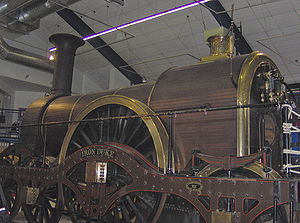
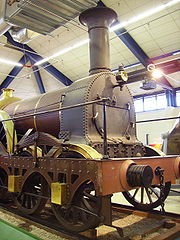
Hunslet Austerity 0-6-0ST
The Hunslet Engine Company Austerity 0-6-0ST is a steam locomotive designed for shunting. The class became the standard British shunting locomotive during the Second World War, and production continued until 1964 at various locomotive manufacturers....
as part of the Great Western 150 celebrations. The boiler certificate has expired so it cannot currently be steamed.
It is normally housed at the National Railway Museum
National Railway Museum
The National Railway Museum is a museum in York forming part of the British National Museum of Science and Industry and telling the story of rail transport in Britain and its impact on society. It has won many awards, including the European Museum of the Year Award in 2001...
at York
York
York is a walled city, situated at the confluence of the Rivers Ouse and Foss in North Yorkshire, England. The city has a rich heritage and has provided the backdrop to major political events throughout much of its two millennia of existence...
, although it has also visited the Didcot Railway Centre
Didcot Railway Centre
Didcot Railway Centre, located in the town of Didcot in the English county of Oxfordshire, is based around the site of a comprehensive "engine shed" which became redundant after the nationalisation of the UK railways, due to the gradual changeover from steam to diesel motive power.-Description:The...
, which has a section of broad gauge track. In 2006 it has been moved to Bristol
Bristol
Bristol is a city, unitary authority area and ceremonial county in South West England, with an estimated population of 433,100 for the unitary authority in 2009, and a surrounding Larger Urban Zone with an estimated 1,070,000 residents in 2007...
where it is the centrepiece of the Nine Lives of Isambard Kingdom Brunel
Isambard Kingdom Brunel
Isambard Kingdom Brunel, FRS , was a British civil engineer who built bridges and dockyards including the construction of the first major British railway, the Great Western Railway; a series of steamships, including the first propeller-driven transatlantic steamship; and numerous important bridges...
exhibition in the Maritime Heritage Centre adjacent to the SS Great Britain
SS Great Britain
SS Great Britain was an advanced passenger steamship designed by Isambard Kingdom Brunel for the Great Western Steamship Company's transatlantic service between Bristol and New York. While other ships had previously been built of iron or equipped with a screw propeller, Great Britain was the first...
.
In January 2010, the replica arrived at the Gloucestershire Warwickshire Railway
Gloucestershire Warwickshire Railway
The Gloucestershire Warwickshire Railway is a volunteer-run heritage railway on the Gloucestershire/Worcestershire/Warwickshire Borders that has reopened the closed railway line between Laverton Halt and Cheltenham Racecourse railway stations in Gloucestershire/Worcestershire., it currently...
where it will form part of a static display of Great Western Railway locomotives celebrating the 175th anniversary of the GWR
The replica appeared in The Railway Series
The Railway Series
The Railway Series is a set of story books about a railway system located on the fictional Island of Sodor. There are 42 books in the series, the first being published in 1945. Twenty-six were written by the Rev. W. Awdry, up to 1972. A further 16 were written by his son, Christopher Awdry; 14...
book Thomas and the Great Railway Show, in which it was portrayed with whiskery eyebrows and a walrus moustache
Walrus moustache
The walrus moustache is characterized by whiskers that are thick and bushy in nature. Its name derives from the fact that the whiskers usually droop over the mouth, giving an appearance to the human face that is very similar to that of a walrus.-History:...
.
External links
- http://www.broadgauge.org.uk/history/history.html


